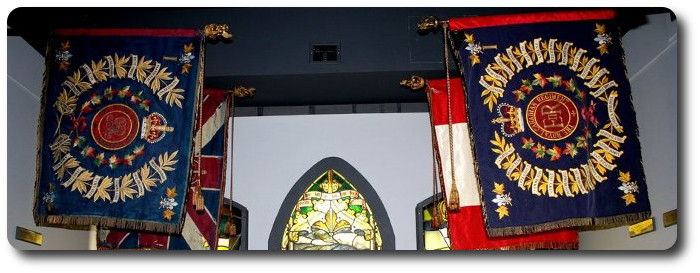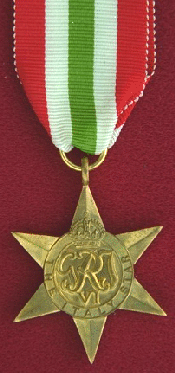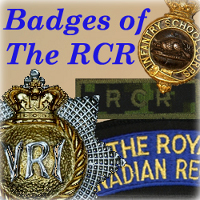
Researching The Royal Canadian Regiment

The Italy Star was awarded for one day operational service in Sicily or Italy between 11 June 1943 and 08 May 1945.
"The Moro," Italy
By Captain A. Condy, B.E.M.
The Connecting File, July 1947
This story is a short summary of one of the major battles which the Royal Canadian Regiment fought in Italy, 1943.
To begin this story it will be necessary to go back a few days to bring the readers up to date or "in the picture."
During the latter days in November, the Regiment was situated in strong defensive positions in and around Duronia in the more or less central part of Italy. In early December, the First Division was ordered to the east coast to relieve the 78th British Division, who were at that time still meeting very stiff opposition after crossing the Sangro River.
After the usual scout parties and recce's were completed, the First Division relieved the 78th and carried on the battle on the Adriatic coast. The disposition of the division was as follows: First Bde. right, second Bde. left, third Bde. reserve. The immediate objective of the division was the town of San Leonardo on the north side of the Moro River. To gain this point the plan was as follows: Second Bde. would attack at their front and swing in towards First Bde., First Bde. would assist by having a platoon of the Royal Canadian Regiment act as a standing patrol, to cover the Engineers, who were to build a bridge on the main road to Leonardo, the Hastings and Prince Edward Regiment would do a feint attack on the extreme right sector of the First Bde. front.
The standing patrol was from the Carrier Pl. and was under command of Captain A. Condy, BEM, with Lt. G. Potts (now Major G. Potts, M.C.,) as second in command. They went across the river and reached their covering position but the Engineers could not build the diversion due to the fact that the Second Bde. attack wasn't as successful as had been planned. The H. and P.'er feint attack was a success and they withdrew according to plan. The next day they recrossed the Moro and stayed.
The next day began the battle proper for San Leonardo. The plan was for the RCR to attack in the direction of San Leonardo from the FDS's of the H & Per while the H. & Per. made a feint attack in the direction of Ortona along the coast road, and the 48th Highrs. made a feint attack towards San Leonardo from the extreme left of the Bde. front. In support the Bn. was to have five Fd. Regts. of Arty. and two Med. Regts. who would put down concentrations of known enemy positions from zero minus sixty until zero, and then remain on call for any support required. One Coy. of MMG. from the SLI. would be in SP. on targets of opportunity until dark, and one Coy. of 4.2 mortars also in SP. Zero hour was set for 1630 hours on the 8th December.
The Bn. Comd., Lt.-CoI. D. C. Spry, planned his attack as follows: "A" Coy. would push off at zero hour and patrol to and occupy their first objective, approximately eight hundred yards along the track to San Leonardo from the F.D.L. of the H. & Per. On reaching this point, they would send the code word Halifax, and then "B" Coy. would leave the start line, patrol to and occupy a position across the road from "A" Coy. and when "B" Coy. were in position they would send the code word Toronto.
On receipt of this code word, "C" Coy. with Comd. Gp., followed by "D" Coy., would leave start line and pass through the forward Coys. to areas ahead which would be good points for "A" and "B" Coys. to attack San Leonardo north and south respectively. Comd. GP. would remain with "A" Coy. while "C" Coy. passed through. When "C" Coy. and "D" Coy. reached their objectives they were to use the code words London and St. Jean. These code words were easy to remember because they were the names of the places where the Coys. of the Regiment were stationed before the war.
When "C" Coy. and "D" Coy were in position, "A" Coy. would pass through "C" Coy. and attack the north while Comd. GP. would remain with "C" Coy. At the same time "B" Coy: would pass through "C" Coy. and attack the south of the town. When these two Coys., "A" and "B," were on their objectives their code words would be Nova Scotia and Ontario respectively, whereas Comd. GP. would move to "B" Coy. area.
The unique thing about this battle was that there wou1d be no assistance from arm our or Ak. guns because the diversion would not be built across the river until first light the following morning.
The Arty. concentration came down as planned and at 1630 hrs. "A" Coy. crossed the S.L. Immediately they came under LMG. fire and some casualties were suffered. A short distance farther on heavy mortar fire caught the Coy. and casualties were fairly heavy, one section under CpI. Meister, MM., were all killed or wounded. The enemy were beaten back and several prisoners taken. By 1900 hrs. "A" Coy. had reported Halifax. At this time word was received that three Coys. of the 48th Highrs. were on their objective as during the afternoon the plan had been changed and the 48th carried out the attack commencing at 1630 hrs. "B" Coy. had already crossed the S. L. also under LMG. fire, and as Major Galloway, the Coy. Commander, had seen "A" Coy. .come under the mortar fire he ordered the Coy. to skirt the right of that area. The Coy. then went slightly off its axis and swung far north before moving back to its proper route After reconnoitering this first opposition no enemy were encountered, and as "B" Coy were so late the C.O. ordered "C" Coy. to advance. "C" Coy. crossed the S.L. and proceeded very slowly to Halifax followed by Comd. GP. escorted by 4 Pl. dismounted. After some delay "C" Coy. passed through "A" and Comd. GP. joined "A". "C" Coy. moved along about 500 yards beyond "A", and en route they surprised eight Germans and took them prisoner, without firing a shot. Right after this "C" Coy. came under heavy fire from LMG's on both sides of the road firing across the road. An armoured car moved up from S. Leonardo, followed by an enemy tank. Some confusion resulted and "C" Coy. was forced to fall back, having had heavy casualties. The wounded who could be reached were brought back and' the Coy commenced to withdraw to "A" Coy. position. They arrived at command post area somewhat disorganized but were soon taken in hand and incorporated into the defences. Meanwhile "B" Coy. had reached their area and pushed patrols out at once. "D" Coy. had meanwhile sent 16 Pl. fwd. to its first bound and this Pl., meeting no enemy, had pushed on to just short of "B" Coy. position. The remainder of the Coy. after crossing the S. L. had come under heavy shell fire and suffered very heavy casualties. The Coy. Comd. Capt. C. H. Lithgow, ordered the Coy. to fall back and on checking found his losses to be so severe that he was forced to use all his effective men to assist the wounded back to cover. His wireless was knocked out so he set forth with an escort to contact the Bn. Lieut. Sterlin, 16 Pl., on finding the remainder of this Coy. not coming up, reported to the Comd. post, and was ordered to take up a defensive position and to patrol back to try to contact his Coy. During this time the enemy were very active and much firing went on down the road where "C" Coy. had contacted them. Shortly after this "A" Coy. reported tanks heard in the gully to the north of our position and a patrol reported tanks stopped along the road to the north-east. Fortunately comms to Arty. were good and the C.O. ordered fire down in a semi-circle around us. The Arty. Rep., Major Murdock, got the targets through quickly and the fire was brought down. The enemy were so close that the C.O. was forced to order fire, cutting the safety zone to a minimum. Some rounds fell short and landed in the area of "A" Coy. and Comd. Gps. Three casualties resulted and some of the mules transporting 3 Pl. mortars were killed. This action drove the enemy off and was perfectly justified, as had the enemy armour penetrated our position with the Tps. only partially dug in casualties would have been very much heavier. Digging was continued rapidly and some enemy shells landed in the area but most of them landed to the south of our position and it is believed that when the enemy saw our shells land in our own area they thought we had withdrawn to the south. The C.O. still continued to engage all the likely F.U.P.'s with artillery fire and by midnight all signs of an attack by the Germans appeared to have died out, although much activity could be heard in the gully to the north.
Wounded were cared for in the building used as Comd. Post and Cpl. Driscoll made a recce of the building defended by 16 Pl. It was decided to establish an RAP there. Capt. Mitchell and Lieut.' Roy, the I. A., made an appreciation and decided that when daylight came our position would be untenable. To carry out with the attack was out of the question, and to stay in the present locality was equally unwise, as the ground was very flat and could not be defended without AfT guns. It was also overlooked from a ridge and after daylight would be shelled even worse than it was then. Lt.-Col. Spry therefore decided to move to the area down the slope from 16 Pls. position where a slight reverse slope could be used to give some protection from shell fire. This was put into execution and "C" Coy. moved off first acting as carrying party and escort to the wounded. Comd. GP. then moved off, followed by "A" Coy. The move was completed without incident, 16 Pl. was placed P/C "A" Coy. and took on the defence of the north part of the area. "C" Coy. the east, the remainder by "E" Coy. Except for shelling nothing further occurred and vigorous patrolling was carried out to prevent surprise. Word was received before daylight that the Brig. was very pleased with the night's work and that Tks. would be across the Moro by daylight and a 2 cm attack was going in. This came off in due course, the tanks advancing in full view, provided a very heartening sight. As large numbers of the enemy had been cut off by our attack and were still between us and the river "C" Coy. sent out a patrol to try to clear these up. Lt. Bindman with a small patrol captured two Germans. Previous to this Capt. Lithgow had reached the Bn. and explained his situation. He was ordered to return and try to evacuate his casualties through the H. & Per and then rejoin us with his effective personnel. We now received word that he was ready to come forward but due to large numbers of enemy infiltrating back he was ordered to remain with the H. & Per until further orders. Later in the day this party fought along with the H. & Per. to repulse a counter attack.
Attempts were made to contact 2 CIB and tanks but this was not successful. Late in the morning a shell landed at the door of the Comd. Post killing three men. At the same time one landed in "C" Coy. area and severely wounded Lieut. Bindman who died of wounds the following day. At 1430 an order was received to move to the original objective S. Leonardo and this was immediately carried out. "B" Coy. left first and after a short interval "C" Coy. left escorting some prisoners and carrying all the wounded. Just after "C" Coy. were clear and Comd. GP. were about to move off, the enemy, estimated one Bn., put in a strong counter attack. "A" Coy. and Comd. GP. moved to positions and fighting commenced. The position was almost encircled, the enemy having worked around on three sides, only the side to the river being open and this was under fire. After about twenty minutes the C.O" decided that rather than be completely surrounded it was better to get out and carry out the Brig.'s orders. He accordingly ordered "A" Coy. to fight on until Comd. GP. were clear and then to withdraw fighting its way back by stages. Comd. GP. 'withdrew by breaking up in small parties and making a run for it over the open ground. On reaching the low ground near the river, reorganization was carried out and the group I moved towards the river crossing. "A" Coy. continued to fight on and then withdrew by Pls. after inflicting heavy casualties on the enemy. The last in 'position were 8 Pl. under Lt. Quayle and 16 Pl. under Lt. Sterlin. 16 Pl. was being heavily pressed and 8 Pl. was trying to assist It by fire. 8 Pl. finally ran out of ammunition and had to withdraw. All of 16 Pl. withdrew leaving Lt. Sterlin and ten men in the house. The enemy closed in and reached the house but were driven off by the determined efforts of the defenders to hold at all costs. After dark the remainder of the Pl. under Lt. Sterlin withdrew to the H. & Per. area.
Meanwhile the Comd. GP. and "C" Coy reached the area where the crossing was being built and the C.O. decided to dig in to defend this area until he could re-form the Bn. At this time word was received from "B" Coy. that they had contacted the Sh. of C. in San Leonardo and the C.O. decided to push on to there. The Brig. was informed of this plan and he decided to have the Bn. withdraw to the high ground overlooking the river from our side so as to have a firm base to assist the H. & Per. to hold their bridgehead. This plan was followed and "B" Coy. rejoined the Bn. the following morning.
At 1800 hrs. the Brig. decided to have the Bn. move to occupy the area between San Leonardo and the H. & Per. This meant that the Bn. would again be on the ground that they had fought so hard to gain. "A" Coy. moved off to clear the area and when they reported it clear the Bn. moved forward, again. This time the Bn. had lots of Ak. support so the C.O. formed a tight group that he called an Ak. island.
In the meantime the 2 CIB. were attacking in front and we were subjected to a few shells which did very little damage. It was soon apparent that there was very little chance of a counter-attack so the Bn. collected their dead, also the enemy's, and a burial service was conducted by the padre of the H. & Per., Capt. Goforth, M.C. It is worthy of note that the main road in this area was called the Royal Canadian A venue and the house where Lt. Sterlin held on during the counter-attack, was called Sterlin Castle. The hill was known as Slaughter House Hill.
The casualties for this phase of the battle were "two officers and nineteen OR's killed with fifty-three OR's wounded and missing. The Moro River was now in our hands and the Division had as their next objective the city of Ortona which was to be a bloody battle. This battle of the Moro proved to all that the First Canadian Division was battle experienced and also proved that the Royal Canadian Regiment was able and ready to carryon the traditions and honours that had been won by the Regiment since its birth.
The Coy. Comd. during this period were.
- "A" Coy. - Major R. G. Liddell, MBE (then Captain).
- "B" Coy. - Major A. S. A. Galloway.
- "C" Coy. - Captain G. H. Lithgow.
- SP. Coy. - Capt. A. F. Mitchell.
- Mortar Pl. - Lt. Dagnall.
- Carrier Pl. - Captain A. Condy, BEM.
- Ak. Pl. - Captain S. Small.
- HQ. Coy. - Major E. G. Nelson.


